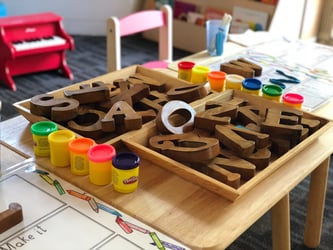Need help creating a daycare daily schedule? You’re not the only one.
Keeping up with the demands of a daycare center can be tough. Juggling a hundred things at once, manning the phones, attending open houses, handling bills and keeping parents’ best interests in mind. On top of the multiple hats directors may wear, adding daycare daily schedules to the task list can seem daunting. But creating a daily schedule is important in running a successful daycare center. Our daily schedule templates make it easy to manage the kids’ time while keeping everyone happy. If they know they have time to play, they can focus on knowing their responsibilities.
Not to mention, creating a daily schedule will help the children in every daycare to know what they have to do every day and even get used to it. This helps them become responsible and disciplined individuals which they can use in their growing years or when pursuing higher education.
If you want to save some time on creating a schedule, download one of our free daycare templates. We have a variety of themes and templates available. You can choose which works best for your daycare business.
Table of Contents:
- Tips for Creating Developmentally Appropriate Daily Schedules
- A Simple Trick Daycare Directors Use to Free Up Time
Why You Need a Daycare Daily Schedule
In preschool classrooms, the relationships between children and their teachers are of great importance. By keeping to a schedule, there is organization and order. This helps the children feel secure and comfortable. Most schedules give children choices, balanced and planned activities (small vs. large groups, quiet times vs. active times, teacher-directed vs. Child-directed), individualized activities, and the opportunity to play with peers. Other important reasons to have schedules are:
Maximizes Learning
Studies show that children learn differently than adults and have different daily needs than adults have. They need a flexible, balanced routine to maximize their learning through play.
Provide Comfort
Establishing consistency in daily routines with your child will greatly aid in their upbringing. This is because it helps them stay on task and lets them know that rules and expectations are not arbitrary but are required for their benefit.
Children thrive in the structure and consistency of routine. While some disruptions are inevitable, we have an extensive schedule to ensure that daily routines are not interrupted and that children remain happy and healthy.
Why Use a Daycare Schedule Template
It may be tempting to wing your daycare lessons plans, but it can be incredibly beneficial to schedule them in advance. Daycare daily schedules help you keep track of your activities and stay organized, giving you more time to focus on the things that matter. Here are a few reasons why they can be useful:
Preparation: By organizing a daycare activity schedule, you will spend less time running to the store for supplies and more time playing fun games.
Incorporating Key Learning: One key to preserving your sanity is making a daily plan that incorporates activities that cover the essential skill areas. For example, dramatic play enhances social skills, while finger painting promotes fine motor skill development.
Establish Consistency: Alignment with the routines of a preschool classroom can make your child’s transition into your center easier. Naps and meals should be scheduled at the same time every day.
Happier Families: Families adore getting a sneak peek at the day of their child’s class. If you post what is going on, they can be more involved in their child’s education… and you can save yourself from fielding frustrating calls from angry and exhausted parents.
Lower Employee Turnover Rate: It’s simple. Having a daily schedule at your daycare center will reduce staff turnover, increase job satisfaction and make it easier to follow the daily routine.
Download Our Free Daycare Schedule Template
Planning, building and designing a daycare daily schedule takes time, which you and your staff are short on. Avoid the stress of starting from scratch. Check out these daycare schedule templates our team built to simplify the task for you.
Maintaining Regulation with a Daycare Daily Schedule
Daycare regulations and licensing are a bit of a mystery for most owners and the parents who depend on them. But whether your center runs on program hours or operates as a family daycare, staying in compliance is critical to creating a safe and stable learning environment for children. By using a daycare schedule, you’re ensuring your center stays up to date on codes and licensing depending on the age group. An example is making sure enough supervised potty breaks are planned for children under 3 and making sure you have enough staff to supervise. Here are examples of how to plan ahead to make sure you’re hitting childcare regulations:
- Schedule 2 staff on site when 1 or more children are present
- Schedule at least 1 staff member to be present with 1st aid/CPR training at all operating hours.
- Schedule 1 staff member who is certified in administration of meds whenever a child is present who requires medicine
- Staffing ratios must be maintained at all times, including nap time.
- Maintain compliance with your local health department by planning snacks & meals ahead of time.
- Plan physical outdoor & indoor activities daily.
- Be sure to include emotional/social learning time.
- And many more need to be included in your daily schedule to maintain regulation.
Free Sample Daycare Schedules for Inspiration
Brainstorming daily schedules is a process, especially when you need one for a variety of situations. But don’t worry. Our team has built a half-dozen daycare daily schedule samples that will simplify the process, including a sample daycare schedule for toddlers.
Indoor Daily Schedule (For Rainy Days or Cold Weather)
Stormy weather doesn’t have to stop the fun. Even if your outdoor plans have been canceled, you can still find plenty of fun rainy-day activities to do at home.
When creating your daycare schedule, keep this list of what to do on a rainy day in your pocket for the next drizzly (or snowy) afternoon—it has plenty of inspiration, from relaxing self-care ideas to games to play with the kids.
Here are fun ways to keep the kids active on rainy days to incorporate in your daycare daily schedule.
Obstacle Course:
It’s raining outside! The kids are getting antsy. What do you do? Create an indoor obstacle course and get the little ones moving! Clear the furniture from the center of the room and lay down a big, thick blanket. Practice physical activities like running, hopping, jumping, flipping and crawling. This is a fun way to work on gross motor skills.
Freeze Dance or Musical Chairs:
The Freeze is the only dance move where the steps are simple-just freeze when the music stops and wait for the next song. Play a variety of music to keep things interesting and encourage everyone to add their own flare.
Scavenger Hunt:
Get the kids’ blood flowing and your mind thinking by creating a scavenger hunt. Grab a clipboard, a pen and get up on your hands and knees! Look around your daycare for items that represent the theme and make notes. Hunt for color combos, shapes or pattern match ups. This is a fun activity for any age!
Arts & Crafts:
Add some arts and crafts to your daycare daily schedule to keep their minds occupied. Use materials like craft sticks and buttons to create geometric shapes and bold patterns, or let their creativity go wild and let them create self-portraits with mixed media. Here’s a sample daycare schedule for rainy or cold weather days to get your creativity flowing.
| 8:00 am | Free Play |
| 8:30 am | Crafts |
| 9:30 am | Snacks |
| 10:00 am | Build |
| 10:30 am | Clean up |
| 11:00 am | Active Play |
| 12:00 pm | Lunch Time |
| 12:30 pm | Wind Down |
| 1:00 pm | Naptime |
| 3:00 pm | Wake Up |
| 3:30 pm | Snack |
| 4:00 pm | Independent Play & Pick up |
Outdoor Daily Schedule
To provide optimal health for children, they should engage in physical activities for at least an hour a day. This should come from a combination of active play and organized sports. Playground time is also key for developing social skills like taking turns and conflict resolution.
For health and safety reasons, it’s also beneficial to take lessons outside. Outside time allows children to use what they’ve learned along with their natural curiosity, to explore their surroundings and make connections between what they are learning, how they feel and what they experience. Think about how you could do indoor activities outdoors and adding in an outdoor daily schedule. Check out our sample daycare schedule below for inspiration.
| 7:00 am | Check-in |
| 8:30 am | Free Play Indoors Until Everyone Arrives |
| 9:00 am | Outside Painting |
| 10:00 am | Clean Up |
| 10:30 am | Snacks |
| 10:50 am | Scavenger Hunt for Prizes |
| 11:45 am | Clean Up |
| 11:50 am | Lunch |
| 12:15 pm | Story (While eating lunch) |
| 12:50 pm | Wind Down & Clean Up |
| 1:00 am | Nap Time (Inside) |
| 3:00 pm | Wake Up |
| 3:15 pm | Circle Time & Snack Outside |
| 4:00 pm | Free Play Outside |
General Daily Schedule
This general daycare daily schedule template will help you create a routine that works best for your specific situation. A schedule is a great tool to help guide children through the day so they know what to expect and can prepare accordingly, helping them focus and remain calm.
| 7:00 – 8:00 am | Parent Check-In |
| 7:00 – 8:00 am | Parent Check-In |
| 8:00 – 9:00 am | Breakfast & Cleanup |
| 9:00 – 10:00 am | Circle Time – Conversation, Sing-a-long, Concept Games |
| 10 – 10:30 am | Learning Time |
| 10:30 – 11:00 am | Outdoor Time |
| 10:30 – 11:00 am | Outdoor Time |
| 11:00 – 12:00 am | Lunch & Cleanup |
| 12:00 – 1:00 pm | Arts & Crafts |
| 1:00 – 1:30 pm | Outdoor Time |
| 1:30 – 2:30 pm | Free Choice of Activities |
| 2:30 – 3:30 pm | Nap Time |
| 3:30 – 4:00 pm | Snack & Clean up |
| 4:00 – 4:30 pm | Fine Motor Skill Activities |
| 4:30 – 5:00 pm | Story or Music Time |
| 5:00 – 5:30 pm | Prepare for Pickup |
| 5:30 pm | Checkout |
Sample Daycare Schedule for Toddlers
During this time, the toddler is extremely outgoing and displays skills such as crawling, walking and climbing. The toddler is eager to share his or her newfound mobility with others.
It’s important to build a daycare daily schedule around giving the toddlers plenty of opportunities to build on their language and gross motor skills. Toddlers will benefit from more time to play with a group, rather than having individual activities. Your schedule should encourage interactions for the children to learn about cooperation. Here is a sample daycare schedule for toddlers that incorporates the activities you need for their development.
| 7:00 am | Welcome Children + Breakfast |
| 8:00 am | Potty Time & Diaper Change |
| 8:30 am | Free Play |
| 9:00 am | Clean Up Time |
| 9:15 am | Outdoor Fun (Depending on Weather) |
| 9:45 am | Potty Time |
| 10:00 am | Circle Time |
| 10:15 am | Small Group Projects |
| 10:45 am | Potty Time + Wash Hands |
| 10:55 am | Snack! |
| 11:10 am | Diaper Changes |
| 11:30 am | Outdoor Play |
| 12:00 pm | Wash Up |
| 12:10 pm | Lunch! |
| 12:55 pm | Potty Time |
| 1:00 pm | Nap! |
| 3:00 pm | Wake + Potty Time |
| 3:10 pm | Snacks |
| 3:30 pm | Crafts or Story Telling |
| 3:45 pm | Small Group Play |
| 4:15 pm | Potty Time |
| 4:25 pm | Outdoor Play! |
| 5:15 pm | Diaper Change |
| 5:15 pm | Play Time or Movie |
| 5:20 pm | Clean Up & Get Ready to Go Home |
Daily Schedule for Infants
Creating a daycare daily schedule for infants (6 weeks to 18 months) is an important task so that these little ones can enjoy the best and most effective educational development. Infants can never get enough interaction – they’re always exploring the world around them! Active infants need plenty of exercise and sleep to grow healthy and strong.
Infants, like toddlers and preschoolers, are still growing in their social, emotional and physical development as they grow from six to twelve months. Knowing this, a daily schedule for infants should include a lot of flexibility regarding activities and entertainment. This will aid in the infant’s development.
While some infant care centers do not share daily schedules, it is important to have a general guideline. Certain rituals, like feedings and changings or routine activities, ensure your baby is growing and learning the way he or she should. Use this sample daycare schedule to get started.
| 6:30 – 7:30 pm | Greet Families |
| 7:30 – 8:00 pm | Bottle Feeding |
| 8:00 – 9:00 pm | Rocking & AM Nap |
| 9:00 – 9:30 pm | Learning Toys |
| 9:30 – 10:00 pm | Sensory Activity |
| 10:00 – 10:30 pm | Tummy Time |
| 10:30 – 11:00 pm | Reading |
| 11:00 – 12:00 pm | Lunch Bottle Feeding |
| 12:00 pm – 2:30 pm | Burp & Nap Time |
| 2:30 pm – 3:00 pm | Snack |
| 3:00 pm – 3:30 pm | Tummy Time |
| 3:30 – 4:30 pm | Music Exploration |
| 4:30 – 5:30 pm | Afternoon Nap |
| 5:30 – 6:30 pm | Bottle Feeding & Get Ready to Go Home |
Daily Schedule for Preschoolers
Daycare daily schedules for preschoolers can seem like a tall order. But, with a little effort and creativity, you can easily build one that provides the variety and consistency your child needs to grow and learn. Integrating fine motor and language/cognition learning into your daily daycare schedule ensures that future kindergarten students are ready for school.
When planning preschool schedules, include blocks that help your little ones adjust to classroom life and imaginative play. A three-year-old needs table-based activities and task support more than ever before. Here is a sample daycare schedule to help you get started.
| 6:00 – 8:00 am | Welcome Children |
| 8:00 – 8:15 am | Bathroom |
| 8:15 – 8:45 am | Breakfast |
| 8:45 – 9:15 am | Group Time |
| 9:15 – 9:45 am | Outside Activity |
| 9:45 – 10:00 am | Bathroom |
| 10:00 – 10:30 am | Creative Expression |
| 10:30 – 11:00 am | Language & Literacy Activity |
| 11:00 – 11:30 am | Social & Emotional Building Exercise |
| 11:30 – 12:00 pm | Lunch |
| 12:30 – 2:00 pm | Bathroom |
| 2:00 – 2:30 pm | Nap |
| 2:30 – 3:00 pm | Bathroom |
| 3:00 – 3:30 pm | Science/Math |
| 3:30 – 4:00 pm | Afternoon Snack |
| 4:00 – 4:30 pm | Outside Play |
| 4:30 – 5:00 pm | Fine Motor Skill Activity |
Tips for Creating Developmentally Appropriate Daily Schedules
This daycare daily schedule is designed to allow each child to play and learn in their way. Every child’s schedule will be different, with nap times that might vary from day to day. You can create a schedule for any number of children in your care. The things you will need to create the schedule are a tape measure and the children’s names, ages, favorite toys and activities, and nap time preferences and locations. Below are tips on creating and implementing your daily director schedules.
Create a Consistent Routine
Daily routines help children know what to expect, which leads to fewer disruptive behaviors. Create a predictable everyday way that flows consistently. This lets your child focus on her play and learning.
Meet Individual Needs
We know that each child is unique and may have varying needs. In your daycare daily schedule, make all caregiving routines as natural and effortless as possible. Reserve regimented times or routine schedules for the big issues such as feeding and sleeping, not for every little thing.
Create Physical, Social, and Emotional Growth Experiences
You can support development in all areas during everyday interactions and activities. Consider an infant’s diaper change. A parent holding the child, talking to her gently, and making her smile, will help promote social-emotional growth and language development.
With a supportive and accepting environment such as this one, the child not only develops a sense of trust, but he will continue to flourish socially and emotionally.
Allow A lot of Freeplay
Young children thrive when they can direct their own play experiences. When left to their own devices, children can practice what they have observed and learned about their world, test new ideas, and build skills in all areas of development. A child’s play is unique because it is influenced by who she is as a person and her previous experiences.
For example, in a daycare with several toddlers, many like to be near the teacher while she sings. One child goes to the book corner while this happens, and she peeks over the shelves at the group. The child’s mother has said that, at home, her little girl sings all of the songs, but in daycare, she does not join the group until several months later, when she is ready.
Provide Time for Transitions
A schedule for infants and toddlers offers thoughtful transitions that support children’s development as they move from one area of focus to another. These transition times allow parents and caregivers to fit in quiet time, mealtime, outdoors, and talk time.
A Simple Trick Daycare Directors Use to Free Up Time
Building daycare daily schedules is just one of the many responsibilities directors and their staff own. With days packed to the brim, it helps to have a little assistance. That’s why hundreds of daycare directors have turned to Smartcare, the child care management software that simplifies all the tedious administration work to save you and your staff countless hours.
Take just a handful of minutes to see how easy it is to save time and reduce stress with Smartcare. Watch our online demo today!
Get 70+ Editable Daycare Templates for Almost Every Situation
 We know daycare providers like yourself are busy. That's why we made dozens of templates to help you manage the various aspects of your organization. From billing and invoicing to marketing materials, we have it all. Download all 70 today!
We know daycare providers like yourself are busy. That's why we made dozens of templates to help you manage the various aspects of your organization. From billing and invoicing to marketing materials, we have it all. Download all 70 today!











